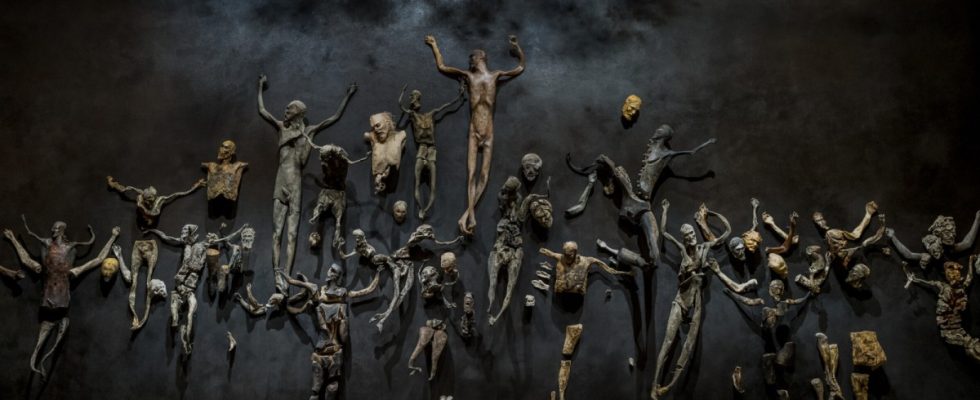For many years, the Italian contribution to the Venice Biennale was considered an expected disappointment. Issue after issue, the vast hall at the Arsenale was crammed with random Italian art production that gave the country an air of provincial backwardness. But in 2017, visitors suddenly experienced a shudder of joy in the dark shipyard basilica. Curated by Cecilia Alemani, who last year led the entire Biennale to great success as artistic director, magic and meaning moved into this national representation.
Largely responsible for this was Roberto Cuoghi’s whimsical Jesus Factory: a vast installation of ovens, tables and inflatable igloos as part of a manufacturing line for crucified Saviors. However, these life-size figures did not have the appearance and form of worshipable figures of suffering for the place above the altar. Cuoghi’s Christi bodies were desiccated, mummified, heat-deformed bodies that seemed more likely to have come from Pompeii or Hiroshima. And the multiple irritations that Cuoghi was able to create with this elaborate manufacture of holy corpses continued into many musty details and the title.
Behind “Imitatio Christi”, as the central work in Cuoghi’s major show in the Fridericianum in Kassel is now called, is the ascetic idea of taking the life of Jesus without needs as a model for one’s own existence. The imitation of Christ, which was understood as an ideal by early Christian sects and mystics, by Francis of Assisi and the Reformation movement of “Devotio moderna”, remains a mystical enigma as a challenge through Cuoghi’s characters. To what extent are the tormented, deformed and baked bodies of God, which are staged in Kassel as a street of the crucifixion on old, smeared museum walls, exemplary for human life? Or is Cuoghi concerned with imitating pain as an objection to human cruelty? Is the multitude of these artificial relics mockery, memento mori, or crazy identification?
Cuoghi transformed into his father for seven years and gained 80 kilos in the process
In the latter subject, the extreme artist, born in Modena in 1973, has already implemented a particularly crazy project. At 24, he began to transform into his father. He gained 180 pounds and remained a clone of his sire in clothing, hairstyle, and demeanor for seven years – with the weight gain causing significant physical damage. Other self-tortures reminiscent of the excessive body art of Orlan, Flatz, Marina Abramović or the Viennese Actionists consisted of letting his fingernails grow until he could no longer grasp anything, or wearing glasses for days that showed everything backwards and upside down.
Roberto Cuoghi
(Photo: Julien Jouanjus)
In contrast to Roberto Cuoghi’s extensive retrospective, which Fridericianum director Moritz Wesseler took over from Geneva in 2017 as head of the Kölner Kunstverein, some aspects of his dazzling oeuvre are missing in Kassel. This completely refuses to be classified into subjects, media or styles. Cuoghi’s projects always have something to do with metamorphoses and metaphysics. But in terms of visualization, this genius of the morbid followed all the experimental paths that were trodden in 20th-century art: from surrealist painting and pop art to wild happenings to disturbing sound works and new media, influences and methods can be found in Cuoghi’s transformative work .
The current presentation in the large halls of the Fridericianum takes the two exhibitions from 2017 as a starting point and shows the further development of the Jesus workshop. In collaboration with the French industrial designer Matali Crasset, who Cuoghi built large, brightly colored or silvery machines and tools that could come from agriculture, sometimes from an alchemical laboratory, the cross smarter is continued in a broader industrial context. The figures, heads and body parts formed from algae and gelatine are impaled on rakes like war trophies, hung like shrunken heads or tied up.
The monsters are happy to be so bad that no one wants to eat them
Archaic battles or the apocalyptic devastation of a nuclear war, in which machines survive but people disappear, are evoked as associations, as are famines and horror films. But Cuoghi’s transformations of life into chimeras of beauty and terror also have humor. In the second major body of work, which is being shown in Kassel, sea creatures, often of extravagant appearance, emerge from the fire. Fired in clay kilns during a happening on the island of Hydra, the clay objects cross crab and fried chicken with human face teeth and eyes. Titled “Putiferio” (German: riot or mess), these series feature monsters who don’t seem unhappy about being so messed up that no one wants to eat them.
Chimeras of beauty and terror: Roberto Cuoghi: “SS(XCP)c” (2018).
(Photo: Alessandra Sofia/The artist, Hauser & Wirth and Galerie Chantal Crousel)
The frightening consistency with which Cuoghi pursues his radical ideas sometimes pushes the limits of what is bearable. Every half hour, a violent sound installation erupts in the exhibition rooms for 90 seconds, which is almost as loud as a jet plane. The more musical version of Cuoghi’s noise compositions can be experienced in a separate blue room with loudspeakers arranged in a circle. The rhythmic-dissonant “reconstruction” of an alleged Assyrian lament from the year 612 BC is the complex fantasy of a music for which there are no sources, played on instruments that the artist invented and built himself, and also exhibits between the bodies of algae – whose heads of Jesus bear a certain resemblance to the likeness of their creator.
Roberto Cuoghi’s art world, anchored in Catholicism and its teachings of guilt, pain and shame, arouses a variety of associations, depending of course on the viewer’s imagination. As a modern mystic with a critical view of the belief in technology, this highly talented radical artist replays creation and does not shy away from fears. A metaphysical ghostly comedy almost as divine as Dante’s descent into hell.
Roberto Cuoghi. Fridericianum, Kassel. Until May 29th.

